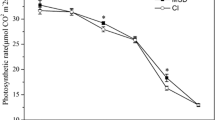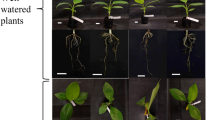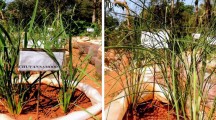Abstract
Dry-raising rice seedlings in nurseries is a key technique in high-yield rice cultivation. The present study of morphological and physiological indexes showed dry-raised seedlings (DRS) had a shorter stature, more developed root systems, and significantly higher soluble sugar, starch, and N content than moist-raised seedlings (MRS), resulting in significantly increased grain yield. Compared to the MRS techniques, the dry-raised measures induced higher levels of abscisic acid (ABA), gibberellins (GA3), and indole-3-acetic acid (IAA) in leaves and roots of seedlings. We then utilized tandem mass tags (TMT) quantitative proteomics technology to analyze the mechanism by which rice exposed to the appropriate drought stress (dry-raised measures) during the seedling stage develop differently. Through mass spectrometry, we identified 281 significantly expressed proteins in roots and 268 in leaves. The differentially expressed proteins were then divided into 23 categories based on MapMan ontology. In addition, the hormonal-related protein expression patterns of DRS were confirmed with RT-PCR at the transcript level. On the basis of these findings, we proposed that appropriate drought stress during the rice seedling stage can change the expression of key proteins involved in nitrogen uptake and translocation, hormone synthesis, photosynthesis, and CHO metabolic processes, thus regulating rice seedling growth. In this process, the differentially expressed key proteins, such as the 14-3-3 protein, GTP-binding protein, and calcium, play important roles in transduction of signals regarding soil drought, and the upregulated heat shock protein, glutathione S-transferases, and peroxidases function in enhancing the stress tolerance of the seedlings under dry-raising nursery conditions. This study established the high yielding mechanism of dry-raised cultivates methods during seedling stage at the protein expression level.






Similar content being viewed by others
Abbreviations
- TMT:
-
Tandem mass tags
- HPLC:
-
High-performance liquid chromatography
- DRS:
-
Dry-raising seedlings
- MRS:
-
Moist-raising seedlings
- TCA:
-
Tricarboxylic acid cycle
- NR1:
-
Nitrate reductase 1
- NiR:
-
Nitrite reductase
- GS:
-
Glutamine synthetase
- GSRI2:
-
Glutamine synthetase root isozyme 2
- ABA:
-
Abscisic acid
- GA3:
-
Gibberellins
- IAA:
-
Indole-3-acetic acid
- JA:
-
Jasmonate
- HSP:
-
Heat shock proteins
- GST:
-
Glutathione S transferases
- TEAB:
-
Triethylammonium bicarbonate
- RT:
-
Room temperature
- MS:
-
Mass spectrometer
- RAP-DB:
-
Rice Genome Annotation Project database
- GOGAT:
-
Glutamate synthase
- AAO:
-
Abscisic aldehyde oxidase
- CCD1:
-
Carotenoid cleavage dioxygenase 1
- ILL1:
-
IAA-Amino acid hydrolase ILR1
- GA20OX2:
-
Gibberellin 20 oxidase 2
- LOX2.3:
-
Lipoxygenase 2.3
- AOC 4:
-
Allene oxide cyclase 4
- ACCO:
-
1-Aminocyclopropane-1-carboxylate oxidase
- OPR2:
-
12-Oxophytodienoate reductase 2
References
Burger JC, Chapman MA, Burke JM (2008) Molecular insights into the evolution of crop plants. Am J Bot 95(2):113–122
Campo S, Peris-Peris C, Montesinos L, Peñas G, Messeguer J, San Segundo B (2012) Expression of the maize ZmGF14-6 gene in rice confers tolerance to drought stress while enhancing susceptibility to pathogen infection. J Exp Bot 63(2):983–999
Chauvin A, Caldelari D, Wolfender JL, Farmer EE (2013) Four 13-lipoxygenases contribute to rapid jasmonate synthesis in wounded Arabidopsis thaliana leaves: a role for lipoxygenase 6 in responses to long-distance wound signals. New Phytol 197(2):566–575
Chen YP, Yang WY (2005) Determination of GA3, IAA, ABA and ZT in dormant buds of Allium ovalifolium by HPLC. J Sichuan Agric Univ 23:498–500
Chen F, Li Q, Sun L, He Z (2006) The rice 14-3-3 gene family and its involvement in responses to biotic and abiotic stress. DNA Res 13(16766513):53–63
Chen H, Liang Y, Lin W, Zheng L, Liang K (2007) Quality and physiobiochemical characteristics of the first rice crop seedlings under different raising seedling patterns for early rice and its ratoonal crop (I)—studies on super high-yield ecophysiology and its regulation technology in hybridize rice. Chin Agric Sci Bull 23(2):247–250
Comparot S, Lingiah G, Martin T (2003) Function and specificity of 14-3-3 proteins in the regulation of carbohydrate and nitrogen metabolism. J Exp Bot 54(382):595–604
Cox J, Mann M (2008) MaxQuant enables high peptide identification rates, individualized ppb-range mass accuracies and proteome-wide protein quantification. Nat Biotechnol 26(12):1367–1372
Creelman RA, Mullet JE (1995) Jasmonic acid distribution and action in plants: regulation during development and response to biotic and abiotic stress. Proc Natl Acad Sci USA 92(10):4114–4119
Del Viso F, Casaretto JA, Quatrano RS (2007) 14-3-3 Proteins are components of the transcription complex of the ATEM1 promoter in Arabidopsis. Planta 227(1):167–175
Deryng D, Conway D, Ramankutty N, Price J, Warren R (2014) Global crop yield response to extreme heat stress under multiple climate change futures. Environ Res Lett 9(3):034011
Ding Y, Wang Q, Wang S, Huang P (2001) Comparison studies of roots physiology activity between rice dry seedbed seedlings and wet seedbed seedlings. J Nangjing Agric Univ 24(3):1–5
Doebley JF, Gaut BS, Smith BD (2006) The molecular genetics of crop domestication. Cell 127(7):1309–1321
Dong JG, Fernandez-Maculet JC, Yang SF (1992) Purification and characterization of 1-aminocyclopropane-1-carboxylate oxidase from apple fruit. Proc Natl Acad Sci USA 89(20):9789–9793
El-Sharkawy I, Mila I, Bouzayen M, Jayasankar S (2010) Regulation of two germinlike protein genes during plum fruit development. J Exp Bot 61(6):1761–1770
He Y, Wu J, Lv B, Li J, Gao Z, Xu W, Baluska F, Shi W, Shaw PC, Zhang J (2015) Involvement of 14-3-3 protein GRF9 in root growth and response under polyethylene glycol-induced water stress. J Exp Bot 66(8):2271–2281
Islam E, Yang X, Li T, Liu D, Jin X, Meng F (2007) Effect of Pb toxicity on root morphology, physiology and ultrastructure in the two ecotypes of Elsholtzia argyi. J Hazard Mater 147(3):806–816
Ji W, Zhu Y, Li Y, Yang L, Zhao X, Cai H, Bai X (2010) Over-expression of a glutathione S-transferase gene, GsGST, from wild soybean (Glycine soja) enhances drought and salt tolerance in transgenic tobacco. Biotechnol Lett 32(8):1173–1179
Koda Y (1992) The role of jasmonic acid and related compounds in the regulation of plant development. Int Rev Cytol 135:155–199
LeClere S, Tellez R, Rampey RA, Matsuda SP, Bartel B (2002) Characterization of a family of IAA-amino acid conjugate hydrolases from Arabidopsis. J Biol Chem 277(23):20446–20452
Lima L, Seabra A, Melo P, Cullimore J, Carvalho H (2006) Post-translational regulation of cytosolic glutamine synthetase of Medicago truncatula. J Exp Bot 57(11):2751–2761
Lin W, Wang S, Liang Y, Guo Y, He S, Hong L, Zheng L, Weng D, Pang Z (1997) Physioecological study on highyielding cultivation of rice by dryraising seedling and thinspacing transplanting techniques I. Quality and ecophysiological characteristics of rice seedlings grown on dryfertile nursery. Chin J Appl Ecol 8(6):566–570
Lin W, Wang S, Liang Y, Guo Y, He S, Zheng F, Weng D, Hong L, Pan Z (1998) Physio-ecological study on high yielding cultivation of rice by dry raising seedling and thin spacing transplanting techniques II. High yielding formation and its physiobiochemical properties of early rice. Chin J Appl Ecol 9(4):395–399
Lo S-F, Yang SY, Chen KT, Hsing YI, Zeevaart JA, Chen LJ, Yu SM (2008) A novel class of gibberellin 2-oxidases control semidwarfism, tillering, and root development in rice. Plant Cell 20(10):2603–2618
Lu X, Peng L, Tang X, Liu X, Luo Z (1995) Studies on physiological reason for cold resistance of early rice seedlings raised in dry nursery. J Hunan Agric Univ 22(3):225–230
Lu X, Tang X, Peng L, Liu X, Zheng X, Luo Z (1996) The characteristics of morphology, physiology and biochemistry of late rice plants cultivated by raising seedlings with dry nursery management. J Hunan Agric Univ 23(4):307–315
Lu X, Peng L, Tang X, Liu X, Luo Z (1997) Studies on the morphology, tissue structure and physiological characteristics of early rice (Oryza sativa L.) seedlings raised in dry nursery. Acta Agron Sin 23(3):360–369
Marrs KA (1996) The functions and regulation of glutathione S-transferases in plants. Annu Rev Plant Biol 47:127–158
Mishra A, Salokhe V (2008) Seedling characteristics and the early growth of transplanted rice under different water regimes. Exp Agric 44(03):365–383
Netto AT, Campostrini E, de Oliveira JG, Bressan-Smith RE (2005) Photosynthetic pigments, nitrogen, chlorophyll a fluorescence and SPAD-502 readings in coffee leaves. Sci Hortic 104(2):199–209
Pitts RJ, Cernac A, Estelle M (1998) Auxin and ethylene promote root hair elongation in Arabidopsis. Plant J 16(5):553–560
Ramachandra RA, Chaitanya KV, Vivekanandan M (2004) Drought-induced responses of photosynthesis and antioxidant metabolism in higher plants. J Plant Physiol 161(11):1189–1202
Redona E, Mackill D (1996) Genetic variation for seedling vigor traits in rice. Crop Sci 36(2):285–290
Schaller F, Biesgen C, Mussig C, Altmann T, Weiler EW (2000) 12-Oxophytodienoate reductase 3 (OPR3) is the isoenzyme involved in jasmonate biosynthesis. Planta 210(6):979–984
Schwartz SH, Tan BC, McCarty DR, Welch W, Zeevaart JA (2003) Substrate specificity and kinetics for VP14, a carotenoid cleavage dioxygenase in the ABA biosynthetic pathway. BBA-Biomembr 1619(1):9–14
Sehnke PC, Chung HJ, Wu K, Ferl RJ (2001) Regulation of starch accumulation by granule-associated plant 14-3-3 proteins. Proc Natl Acad Sci USA 98(2):765–770
Seo M, Peeters AJ, Koiwai H, Oritani T, Marion-Poll A, Zeevaart JA, Koornneef M, Kamiya Y, Koshiba T (2000) The Arabidopsis aldehyde oxidase 3 (AAO3) gene product catalyzes the final step in abscisic acid biosynthesis in leaves. Proc Natl Acad Sci USA 97(23):12908–12913
Sharp RE, LeNoble ME (2002) ABA, ethylene and the control of shoot and root growth under water stress. J Exp Bot 53(366):33–37
Sinclair T, Horie T (1989) Leaf nitrogen, photosynthesis, and crop radiation use efficiency: a review. Crop sci 29(1):90–98
Solaiman M, Hirata H (1997) Effect of arbuscular mycorrhizal fungi inoculation of rice seedlings at the nursery stage upon performance in the paddy field and greenhouse. Plant Soil 191(1):1–12
Stenzel I, Hause B, Miersch O, Kurz T, Maucher H, Weichert H, Ziegler J, Feussner I, Wasternack C (2003) Jasmonate biosynthesis and the allene oxide cyclase family of Arabidopsis thaliana. Plant Mol Biol 51(6):895–911
Thimm O, Bläsing O, Gibon Y, Nagel A, Meyer S, Krüger P, Selbig J, Müller LA, Rhee SY, Stitt M (2004) mapman: a user-driven tool to display genomics data sets onto diagrams of metabolic pathways and other biological processes. Plant J 37(6):914–939
Van de Poel B, Smet D, Van Der Straeten D (2015) Ethylene and hormonal cross talk in vegetative growth and development. Plant Physiol 169(1):61–72
Voss I, Sunil B, Scheibe R, Raghavendra A (2013) Emerging concept for the role of photorespiration as an important part of abiotic stress response. Plant Biol 15(4):713–722
Walker BJ, VanLoocke A, Bernacchi CJ, Ort DR (2016) The costs of photorespiration to food production now and in the future. Annu Rev Plant Biol 67:107–129
Wang S, Lin W (1999) The mechanism of high-yielding in rice under dry-raising and thin-planting and its regulating technique I. Advances in the mechanism of high-yielding in rice under dry-raising and thin-planting and its prospects. J Fujian Agric Univ 28(1):12–17
Wang Q, Ding Y, Wang S, Huang P, Miao B (2003) Physiological effects of sustainable water saturation in seedbed on rice dry nursery seedlings. Acta Agron Sin 30(3):210–214
Wen H, Zhao J, Zhao W, Mao G (2000) Rooting advantage of rice seedlings nursed by dry-nursing and its impact on characteristics of growth and development of aerial part. J Zhejiang Agric Sci 1:1–5
Yang D, Duang Z, Hang J, Liu C, Wu S (2000) Study on the growth and development characters of dry nursery seedlings and their regularities of yield formation in hybrid early rice III. Characteristics of tillering and earing of dry nursery seedlings. Hubei Agric Sci 6:13–14
Yao Y, Du Y, Jiang L, Liu JY (2007) I Interaction between ACC synthase 1 and 14–3-3 proteins in rice: a new insight. Biochemistry 72(9):1003–1007
Zhang Z, Qu W (2003) Guidance of plant physiology experiments, 3rd edn. Higher Education Press, Beijing. pp 127–132
Zhang Y, Wu H, Wang Z, Xiong F, Xie Y, Li A (1999) Effect of rice seedling raising conditions on rice seedling growth. Chinese J Rice Sci 13(2):86–90
Zhang J, Jia W, Yang J, Ismail AM (2006) Role of ABA in integrating plant responses to drought and salt stresses. Field Crop Res 97(1):111–119
Zhang Z, Zhang Y, Liu X, Li Z, Lin W (2017) The use of comparative quantitative proteomics analysis in rice grain-filling in determining response to moderate soil drying stress. Plant Growth Regul 82(2):219–232
Zhao Y, Ding Y, Chen L, Huang P (2001) Physiological characteristics of drought resistance of rice dry nursery seedlings. Sci Agric Sin 34(3):289–291
Zhou Q, Chen G, Chen L, Wang J, Zhang C, Lu C (2004) Study on antioxidation system in high yield hybrid rice Langyoupeijiu seedlings under dry raising conditions. Bull Bot Res 25(1):80–88
Acknowledgements
This work was sponsored by the National Natural Science Foundation of China (No. 31401306), the Fujian-Taiwan Joint Innovative Centre for Germplasm Resources and cultivation of crop (Fujian 2011 Program, No. 2015-75), the National Key Research and Development Program of China (2016YFD0300508) and the Natural Foundation of Fujian Higher Education Institutions for Young Scientists (Key Project) (JZ160435).
Author information
Authors and Affiliations
Corresponding author
Electronic supplementary material
Below is the link to the electronic supplementary material.
10725_2017_347_MOESM3_ESM.xlsx
The detailed information of the 2918 root proteins from the Rice Genome Annotation Project database (RAP-DB). (XLSX 302 KB)
10725_2017_347_MOESM4_ESM.xlsx
The detailed information of the 2674 leaf proteins from the Rice Genome Annotation Project database (RAP-DB). (XLSX 308 KB)
10725_2017_347_MOESM7_ESM.docx
Figure S1: MapMan overview of leaf photosynthesis proteins with significant differences in abundance in dry-raised seedlings. (DOCX 1502 KB)
Rights and permissions
About this article
Cite this article
Zhang, Z., Huang, F., Shao, C. et al. Differential proteomic analysis of rice seedlings reveals the advantage of dry-raising nursery practices. Plant Growth Regul 84, 359–371 (2018). https://doi.org/10.1007/s10725-017-0347-3
Received:
Accepted:
Published:
Issue Date:
DOI: https://doi.org/10.1007/s10725-017-0347-3




